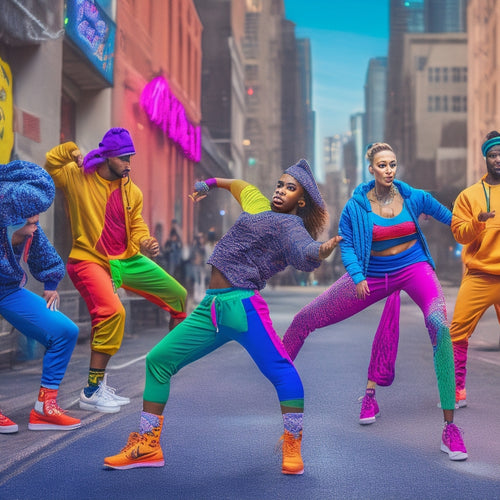
Captivating Performances and Ballet Transformations Unveiled
Share
In the world of enthralling performances and ballet transformations, a new wave of enchanting dance experiences has emerged, redefining our connection with classical narratives. Through expressive movements, dancers convey emotional depth, creating a palpable energy that resonates with audiences. Classic stories are reimagined through balletic expression, adding depth and complexity to iconic tales. As dance companies adapt and evolve, they balance tradition with innovation, shaping the art form's dynamic nature in response to societal changes. As the boundaries of ballet continue to expand, the transformations ahead promise to be nothing short of mesmerizing, holding much more in store.
Key Takeaways
• Falling into Dance concert showcased mesmerizing performances with emotional connections through expressive movements, conveying deep emotional depth.
• Classic stories are reimagined through balletic expression, adding depth and complexity to iconic narratives, appealing to new generations of audiences.
• Dancers' emotional connections reflect their skill and dedication, but occasional restrictive choreography limits their full range of motion.
• Ballet transformations breathe new life into classic stories, offering a fresh and enthralling experience, while companies evolve to remain relevant.
• Adaptation and innovation are crucial for dance companies to balance tradition with innovation, driven by artistic growth, cultural trends, and leadership changes.
Enchanting Dance Experiences Unfold
The Falling into Dance concert report revealed a mesmerizing performance that showcased a range of emotions and themes, with dancers demonstrating professionalism and commitment, despite some limitations in choreography.
The dancers' expressive movements effortlessly conveyed emotional connections, drawing the audience into the narrative. The performance's emotional depth was palpable, with each dancer bringing a unique energy to the stage.
The choreography, while complex, occasionally felt restrictive, limiting the dancers' full range of motion. Nevertheless, the performance's impact was undeniable, leaving the audience in awe.
The dancers' ability to form emotional connections with the audience through their movements was a reflection of their skill and dedication.
Transforming Classics Into Ballet
Through the masterful fusion of classical narratives and balletic expression, iconic stories are reborn, as seen in Dorothy Jemison's The Bonnie and Clyde Ballet. This ballet interpretation breathes new life into classic stories, allowing audiences to experience familiar tales in a fresh and enthralling way.
-
Classic stories are reimagined through balletic expression, creating a unique and enthralling experience.
-
The fusion of classical narratives and dance enables a deeper emotional connection with the audience.
-
Ballet interpretation allows for a new layer of depth and complexity to be added to classic stories.
- The transformative power of dance enables classic stories to be reborn, appealing to a new generation of audiences.
Evolution of Dance Companies
As dance companies navigate the ever-changing landscape of the performing arts, they must adapt and evolve to remain relevant, a reflection of the dynamic nature of the art form.
The evolution of dance companies is a demonstration of their ability to reinvent themselves, driven by artistic growth and creative direction. Over time, companies undergo transformations, shaping their unique aesthetic and artistic voice.
This metamorphosis is often fueled by changes in leadership, shifts in artistic vision, and responses to cultural and societal trends. As companies evolve, they must balance tradition with innovation, ensuring their continued relevance in the performing arts landscape.
Frequently Asked Questions
How Do Dance Companies Balance Traditional and Modern Approaches to Ballet?
Dance companies balance traditional and modern approaches to ballet through artistic fusion, blending classical revival with innovative techniques, creating a unique aesthetic that honors heritage while pushing boundaries, appealing to diverse audiences.
What Role Does Cultural Diversity Play in Contemporary Dance Performances?
Cultural diversity plays a pivotal role in contemporary dance performances, fostering cultural fusion and racial representation, as companies aim to showcase diverse voices, breaking down barriers and promoting inclusivity through innovative, boundary-pushing choreography.
Can Dance Be an Effective Tool for Social and Political Commentary?
Like a masterfully crafted puzzle, dance can be an effective tool for social and political commentary, leveraging body language to convey powerful messages, as seen in protest art, where choreographed movements become a potent form of resistance and activism.
How Do Choreographers Select Music for Their Dance Pieces?
Choreographers select music for their dance pieces by drawing melodic inspiration from diverse genres, cultures, and emotional landscapes, often fusing rhythmic patterns to create a harmonious synergy between movement and sound, evoking a profound emotional resonance.
What Training and Preparation Do Professional Dancers Undergo?
In the Renaissance era, court jesters would often moonlight as dancers, but in modern times, professional dancers undergo rigorous training, prioritizing physical conditioning and injury prevention through cross-training, Pilates, and yoga to guarantee a long and healthy career.
Related Posts
-

Get Certified in Dance Makeup With Online Courses
You can gain a recognized certification in dance makeup through online courses, which demonstrate your expertise and ...
-

Top Dance Makeup Tools for Perfect Stage Looks
To create a flawless stage look, you'll need the right tools and techniques. Start with high-quality makeup brushes, ...
-

Hip Hop Dance Apparel for Style and Function
Hip hop dance apparel combines style and functionality, so you can move with confidence and flair. Look for breathabl...


